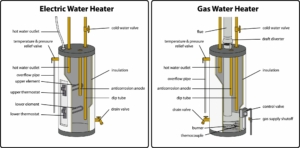Maintain your water heater
Over time, minerals suspended in your incoming household water supply can settle to the bottom of your water heater and build up quite an accumulation. The harder your water, the more quickly this can happen.
For gas water heaters, in particular, with burners on the bottom, this accumulated layer of deposits can act as an insulation blanket, cutting down the burner’s efficiency, increasing energy costs, and, in some cases, leading to premature failure of the tank itself.
Sediment can also get stirred up by incoming water and carried to faucet aerators, shower heads, and washing machine filters. It can clog these fittings causing stuttering, spurting, and, in some cases, severe restriction of water flow.
Annually draining your water heater can greatly reduce the risk of damage caused by sediment and prolong the life of your water heater. A licensed plumber can do the job for you or you can follow the steps below to easily drain the water heater yourself.
- Turn off the Water Supply – If you have an electric water heater, turn off the power at the breaker box. If yours is a gas heater, turn the thermostat to the “pilot” setting. Connect a hose to the drain valve located close to the thermostat, but don’t open the valve yet. Turn off the cold-water supply that feeds the water heater.
- Drain the Hot Water – Inside your house, open up one of the hot-water faucets in one of your sinks or tubs. This will prevent a vacuum from forming in the lines. Go back to the water heater, and open the drain valve to drain the hot water out of the tank. Make sure the far end of the hose is draining somewhere that won’t be harmed by hot water. An outside driveway is ideal.
- Flush out the Remaining Sediment – Once the water stops flowing out of the far end of the hose, turn the water supply back on. This will flush out any remaining sediment left behind in the heater. Once the water runs clear from the end of the hose, close the DRAIN valve. Don’t forget to turn the hot water faucet inside your house back off.
The heating element could possibly blow if there is no water in the tank. Some tanks may need to be completely full in order to prevent damage. When in doubt, always read the warnings and instructions on the tank label carefully because each tank may vary! - Test the Pressure-Release Valve – Turn the power supply to the water heater back on at the breaker box (or the thermostat), after the tank has filled with water. Once the water temperature has been brought back up, test the pressure-relief valve according to the manufacturer’s instructions. This safety device is designed to prevent excess pressure build-up or overheating inside the tank. If it’s faulty, you may need to have it replaced by a licensed plumber.
If you would like us to inspect your home, please feel free to contact us.


.png)

